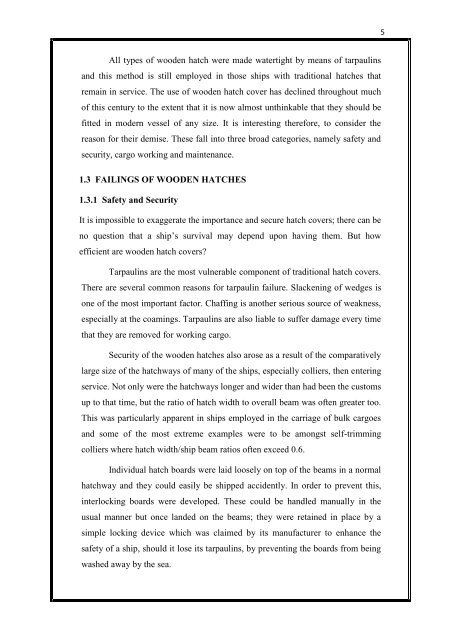Single pull macgregor type hatch cover.pdf - Cochin University of ...
Single pull macgregor type hatch cover.pdf - Cochin University of ...
Single pull macgregor type hatch cover.pdf - Cochin University of ...
Create successful ePaper yourself
Turn your PDF publications into a flip-book with our unique Google optimized e-Paper software.
All <strong>type</strong>s <strong>of</strong> wooden <strong>hatch</strong> were made watertight by means <strong>of</strong> tarpaulins<br />
and this method is still employed in those ships with traditional <strong>hatch</strong>es that<br />
remain in service. The use <strong>of</strong> wooden <strong>hatch</strong> <strong>cover</strong> has declined throughout much<br />
<strong>of</strong> this century to the extent that it is now almost unthinkable that they should be<br />
fitted in modern vessel <strong>of</strong> any size. It is interesting therefore, to consider the<br />
reason for their demise. These fall into three broad categories, namely safety and<br />
security, cargo working and maintenance.<br />
1.3 FAILINGS OF WOODEN HATCHES<br />
1.3.1 Safety and Security<br />
It is impossible to exaggerate the importance and secure <strong>hatch</strong> <strong>cover</strong>s; there can be<br />
no question that a ship’s survival may depend upon having them. But how<br />
efficient are wooden <strong>hatch</strong> <strong>cover</strong>s?<br />
Tarpaulins are the most vulnerable component <strong>of</strong> traditional <strong>hatch</strong> <strong>cover</strong>s.<br />
There are several common reasons for tarpaulin failure. Slackening <strong>of</strong> wedges is<br />
one <strong>of</strong> the most important factor. Chaffing is another serious source <strong>of</strong> weakness,<br />
especially at the coamings. Tarpaulins are also liable to suffer damage every time<br />
that they are removed for working cargo.<br />
Security <strong>of</strong> the wooden <strong>hatch</strong>es also arose as a result <strong>of</strong> the comparatively<br />
large size <strong>of</strong> the <strong>hatch</strong>ways <strong>of</strong> many <strong>of</strong> the ships, especially colliers, then entering<br />
service. Not only were the <strong>hatch</strong>ways longer and wider than had been the customs<br />
up to that time, but the ratio <strong>of</strong> <strong>hatch</strong> width to overall beam was <strong>of</strong>ten greater too.<br />
This was particularly apparent in ships employed in the carriage <strong>of</strong> bulk cargoes<br />
and some <strong>of</strong> the most extreme examples were to be amongst self-trimming<br />
colliers where <strong>hatch</strong> width/ship beam ratios <strong>of</strong>ten exceed 0.6.<br />
Individual <strong>hatch</strong> boards were laid loosely on top <strong>of</strong> the beams in a normal<br />
<strong>hatch</strong>way and they could easily be shipped accidently. In order to prevent this,<br />
interlocking boards were developed. These could be handled manually in the<br />
usual manner but once landed on the beams; they were retained in place by a<br />
simple locking device which was claimed by its manufacturer to enhance the<br />
safety <strong>of</strong> a ship, should it lose its tarpaulins, by preventing the boards from being<br />
washed away by the sea.<br />
5

















